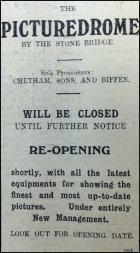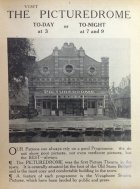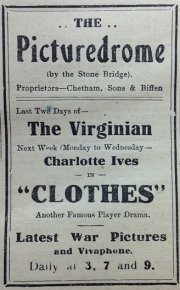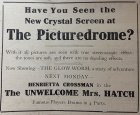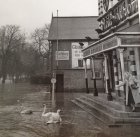Bedford
Cinema History
Places > Bedford > Cinemas > Bedford Cinema History Project
The Picturedrome Cinema
The Embankment, Bedford, 'At the foot of the old stone bridge'
Home | Picturedrome | Sources | Images
The Picturedrome Cinema
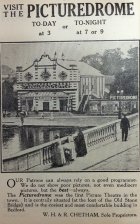
The Picturedrome, also known as the ‘Drome’ and much later as ‘The Fleapit’,
was Bedford’s first purpose-built cinema and opened its doors on 2nd May 1910.
Owned by Chetham, Sons and Biffen local boat-builders, it was leased and
run by the Blake brothers initially. However, in the months following the
opening of the Empire in Bedford in 1912 by the Blakes, the Chethams
became sole proprietors of the Picturedrome. Architects, Anthony and Usher of St
Paul’s Square Bedford, designed the highly decorative stone and brick building
with circular windows on the Embankment, by the River Ouse. It was located as it
said in its advertisements, ‘at the foot of the old stone bridge’. By 1916 the exterior had been painted in contrasting colours to give an even more
dramatic effect. At night time it was described as ‘the most brilliantly
illuminated building in Bedford’.
An enthusiastic article in the Bedfordshire Times and Independent described the
opening ceremony on 2nd May 1910. The Mayor Mr H.W. Longhurst gave a speech with
gracious replies from Mr W.N. Blake (lessee) and Mr Biffen (owner) about
Bedford’s first electric theatre. The reporter noted that one of the most
interesting films shown was The Life History of a Butterfly. He was impressed
with the spectatorium built for 500 patrons and furnished in a most luxurious
and comfortable manner, ‘The seats in the balcony are lined with plush velvet
and those in the pit with red leather.’ 1. Reassurance was given to
readers that the projection room on the ground floor had been built to the
highest standards so that if a fire broke out, there was no possibility of smoke
reaching the main hall of the cinema. This was a real hazard as the early
nitrate based films were highly flammable.
The cinema had two entrances, one led to the stalls and circle and the other to
the pit. C.D. Gethins recalls that in the 1930s and 40s there were two paydesks
‘ one for the rich, (one shilling and tuppence) and one for the poor, (seven
pence).’ Beryl Irving’s early memory of the Picturedrome was seeing a flickering
and spotty film of Edward VII’s funeral. He had died the week that the cinema
opened in May 1912 and each screening was made more memorable by Mr Blake’s
account of how he had once been spoken to by the King.
Film programmes of news clips and features, were publicised in the local press. In its first few years, the Picturedrome was also prominently advertised, with a photograph, in the annual Bedford Directory. The entry in the 1916 edition announced, ‘Our patrons can always rely on a good Programme. We do not show poor pictures, not even mediocre pictures but the best – always.’ The Picturedome it was claimed, one hot Summer, was one of the coolest spots in Bedford.
At first, the cinema was open Monday to Saturday with two screenings at 7.00
and 9.00 pm and a Saturday afternoon matinee at 3.15pm. Audiences were promised
high-class animated pictures. The films were of course silent accompanied by an
‘orchestra’ or piano. In 1912 one could watch 3 films a week. By 1926, there
were three complete screenings a day at 3.00pm, 7.00pm and 9.00pm. Prominent
newspaper advertisements proclaimed the latest technical developments. ’Have you
seen the new crystal screen at the Picturedrome?’ This promised a much improved
experience of soft tones and no dazzling effects - perfect for the film screened
that week The Glow worm, a story of adventure.
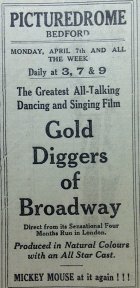 During the
First World War, the cinema showed the latest war pictures and used
the vivaphone to bring sound to films. This was not always successful as it
relied on synchronisation between an actor or singer and the gramophone.
During the
First World War, the cinema showed the latest war pictures and used
the vivaphone to bring sound to films. This was not always successful as it
relied on synchronisation between an actor or singer and the gramophone.
On December 30th 1929, it was the first cinema in Bedford to show the 'Talkies'
using the Warner Electric Sound System and screening an American film Fox Movietone Follies. A photographer recorded this event showing staff standing on
the steps out side the Picturedrome just before film started - usherettes, kiosk
staff, commissionaire and manager all in their elegant uniforms (see photograph
reproduced in the Bedford Record 3rd April 1980). 2. This
was a
dramatic improvement and the Bedfordshire Times commented, ‘The 'Talkies' have
proved an immense attraction and ‘house-full’ seems to be the order of the
evenings’. Advertisements would now promote films in a completely new way – ‘See
and hear’. A month later, at the beginning of 1930, another first – a British
talkie, Blackmail was shown at the Picturedrome. And in February 1930 the
first all colour, talking and singing picture in Bedford, On With the Show was
shown.
News clips were part of the programme - British Movietone News, Pathé Super
Gazette and British Paramount News.
Over the years, various improvements were made to the cinema itself: rumble
seats were introduced in 1922 and the cinema was enlarged to seat 584 patrons.
In the 1950s a new external paybox was built and in 1957, oil filled radiators
added to combat dampness and floor rot.
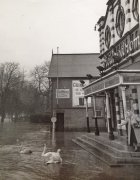 When it first opened the Picturedrome was leased from the Chethams and
programmed by the Blake Brothers, however from mid 1912, advertisements showed
the Chethams had become sole proprietors of the cinema.
Daisy Chetham,
wife of Bob Chetham managed the Picturedrome for several years. She died in 1949
and their son John continued to run the cinema together with the
Plaza on
the other side of The Embankment. In his memories of the Picturedrome in the 30s
and 40s, C.D. Gethins mentions many of the staff including Bedford’s longest
serving commissionaire, Fred Lincoln who was always immaculately dressed. In the
1947 March floods the cinema’s location right beside the river made it
vulnerable to flooding. One patron remembers walking out of the cinema and
straight into the river one night. 3.
When it first opened the Picturedrome was leased from the Chethams and
programmed by the Blake Brothers, however from mid 1912, advertisements showed
the Chethams had become sole proprietors of the cinema.
Daisy Chetham,
wife of Bob Chetham managed the Picturedrome for several years. She died in 1949
and their son John continued to run the cinema together with the
Plaza on
the other side of The Embankment. In his memories of the Picturedrome in the 30s
and 40s, C.D. Gethins mentions many of the staff including Bedford’s longest
serving commissionaire, Fred Lincoln who was always immaculately dressed. In the
1947 March floods the cinema’s location right beside the river made it
vulnerable to flooding. One patron remembers walking out of the cinema and
straight into the river one night. 3.
John Chetham continued to innovate bringing foreign films to Bedford at the
Picturedrome in the late 1940s and giving space to the Bedford Film Society in
its early days from 1950. 4.
However on October 3rd 1964, the Picturedrome, Bedford’s first cinema closed its
doors - John Chetham commenting that four cinemas were too many for a town of
Bedford’s size - and the site was sold for redevelopment.
1. However in Shadows on the Ceiling, Bedfordshire Magazine vol.7 p.44, Beryl Irving remembers sitting on classroom chairs in the Picturedrome.
2. These were later commented on by the Bedfordshire Times in March 1930 p.11. ‘An interesting innovation has been made at the Picturedrome. The new costume worn by the female attendants consists of a dark blue jacket and trousers with a high-fronted ‘tammy’ and a fancy decoration of a cerf rosette and cerf bow and belt. This is a distinctly smart outfit’.
3. The Bedfordshire Times and Independent Friday 6th January 1928 p.10 reported that when the last cinema performance ended on the Tuesday at 11.00pm, the river was up to the steps. Staff stayed until 3.00am and clayed up the doors to prevent flood damage. Later that night the river flowed round the sides of the building.
4. 'In bringing Continental films to Bedford [to the Picturedrome], Mr John Chetham has fulfilled the long wish of the ‘few’. I say few because the patrons of Foreign Cinema are proportionally small in comparison to the cinema-going population of the town.’ The Bedford Opinion March 1948 pp.6-7
Information from Brenda Hands 2013
Sources
Books and Magazines (available at Bedford Library)
- The Bedford Opinion March 1948 pp.6-7
- C.D. Gethins. Klaud’s Kinema Kolumn: The Picturedrome Cinema, Bedford, Bedfordshire Housebound Special, Summer 1993 p.12
- Beryl Irving. Shadows on the Ceiling, Bedfordshire Magazine vol.7 p.44
- G. C. Peck. Bedfordshire Cinemas. Bedfordshire County Council, 1981
- Philip Standley. Cinemas in Bedford 1898-1978, Bedfordshire Magazine vol. 17 pp. 122-127
Newspapers (available at Bedford Library)
- The New Picturedrome, Bedfordshire Times and Independent, Friday 6th May 1910 p.10. 'The opening exhibition of cinematograph pictures in the new Picturedrome...took place on Monday night.'
- Easter Entertainments: The Picturedrome, Bedfordshire Mercury, 12th April 1912 p.8. 'The most brilliantly illuminated building in Bedford'.
- Advertisement in Bedfordshire Mercury 5th July 1912 p.6. The Picturedrome 'will be closed until further notice, re-opening shortly...'
- Advertisement in Bedfordshire Times, 12th March 1915 p.4.' Have you seen the crystal screen at the Picturedrome?'.
- Advertisement in Bedfordshire Times, 5th July 1918 p.1. 'One of the coolest spots in Bedford'.
- Plays and Pictures: the Picturedrome. Bedfordshire Times, 10th January 1930 p.9. 'The talkies...'.
- Bedfordshire Times, March 1930 p.11
- Bedford to Lose an Old Cinema, Bedfordshire Times, 25th September 1964 p.10
- The First Talking Picture Show, Bedford Record, 4th March 1980 p.12
Images
Page last updated: 25th February 2014

